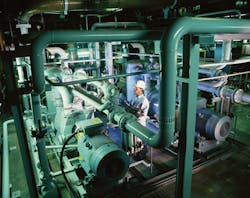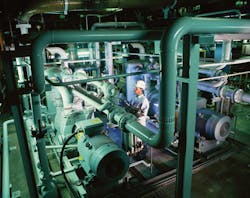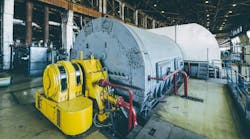By David LoPiccolo
In an effort to increase sustainability while reducing operating costs, many manufacturers address either water or energy consumption, but not both. While saving water or energy reaps both environmental and operating cost benefits, an integrated approach will allow industries to improve long-term competitiveness and productivity.
A new program recently introduced by Siemens, the Integrated Water & Energy Sustainability Platform, is designed to help industrial customers in all markets, particularly automotive, chemical, food and beverage and pulp and paper. Recently, Rich Products Corp. signed on to program for its facilities in California, Ohio and Tennessee.
Concept to Construction
The platform's four-step approach keeps the customer's operation running while water and energy management experts upgrade system processes. This "concept to construction" method first identifies opportunities for improving process efficiency, evaluates potential savings, then implements solutions to realize the savings. The program also "maintains the gains" by providing ongoing service support.
This platform is designed to help companies:
- Minimize risks associated with using new technologies
- Protect assets during modernization
- Maintain a reliable supply of water and energy that meets or exceeds regulatory standards
- Adapt quickly to changing environmental legislation
- Reduce greenhouse gas emissions and water consumption, resulting in a smaller carbon footprint
- Minimize total cost of operation
- Maximize efficient consumption of water and energy
Water/Energy Health Check
When it comes to saving water and energy, a complete assessment of the manufacturer's process is critical. Siemens begins with a "water and energy health check," designed to identify the operation's strengths and weaknesses, and benchmark performance against industry standards.
Field engineers, who are certified in energy efficiency and are experienced with the processes used in the different industries, perform an on-site analysis, which includes:
- An overview of the maturity levels of the water and energy management processes
- The operation's main areas for improvement
- An estimation of the improvement potential
Water/Energy Efficiency Measures
Step 2 involves a complete review of the plant's water and energy performance data, and a comparison to industry best practices. The program team identifies opportunities for improvement, completes a cost/benefit analysis, and develops a road map to improve efficiency and lower the total cost of operation.
This includes developing a prioritized list of water efficiency measures, completing a technical and economic feasibility study that evaluates and summarizes potential results, and preparing an implementation plan and schedule. The final step in the assessment is to reach a consensus with the client company on these results.
The assessment can be completed in as little as eight weeks. From then on, a project manager from Siemens works onsite with the customer's management team.
Technical Realization/Verification
During implementation, Siemens works with the customer to make sure the objectives are achieved. During this stage, all the measures are put in place to achieve the goal.
This step involves:
- Defining the scope and criteria for success
- Final engineering and design
- Reviewing available business and financial options
- Managing and implementing the identified measures
- Supervising the commissioning and start-up, and personnel training
Customer Examples
Two customers in the food processing and pharmaceutical industries are already benefitting from the Integrated Water & Energy Sustainability Platform.
Food and Beverage
A Midwest food processor is saving $364,773 a year in water and energy costs. When the company's executives challenged their plant managers to reduce total operating costs, reduce carbon emissions and optimize water consumption, they partnered with Siemens.
Besides the challenge of lowering costs at all facilities, the plant managers had to continue to maintain product quality while operating in a tight seasonal window within a highly competitive business environment.
An integrated assessment of their 15 factories showed that a majority of steam condensate was being lost during production. Their steam systems were operating with low cycles of concentration, resulting in higher water and energy use.
Siemens developed a road map for optimizing the boiler system, and implemented a standardized boiler pretreatment strategy. Reverse osmosis (RO) systems were installed on the systems with the highest potential return on investment.
The improvement in boiler feedwater quality allows each steam system to operate at maximum cycles of concentration, optimizing both water and energy use. As a result, this food processor has achieved:
- Energy reduction of 12.2 MMBtu/hr
- Boiler make-up water reduction of 5072.9 gal/hr
- NOx emissions reduction of 10.6 klb/yr
- CO2 emissions reduction of 5369.5 klb/yr
Pharmaceutical
A U.S. pharmaceutical manufacturer is increasing profits while conserving water and meeting strict wastewater discharge regulations. Besides the need for greater operating efficiency, the manufacturer faced strict regulations, which if unmet, would have resulted in severe financial penalties.
After performing a comprehensive site assessment, Siemens identified inefficiencies in the production process of this operation that required 150 gpm of make-up water. Rather than implement a potentially wasteful continuously recirculating water system, the customer chose a sanitize/start/stop (S3) system that would reduce water and energy consumption while minimizing wastewater production.
As a result, the manufacturer is annually saving:
- $77,105 in raw water and filters
- $28,789 in electricity
- $2,469 in water softener
An additional 10-year projected savings of $1,370,377, including projected utility cost increases, is also forecasted.
Conclusion
As these case studies show, a thorough assessment, followed by successful implementation, can pay off for today's industrial operations. The synergy created when water and energy management are integrated can give manufacturers the advantage to compete in a tough business climate.
It all starts with the awareness gained from collecting and analyzing the onsite data; this is crucial, as you can't manage what you don't measure.
Once the assessment determines what level the facility has reached for managing the water/energy process, the next stage is implementing the solutions that will deliver results. "Maintaining the gains" is the final step for long-term success.
About the Author: David LoPiccolo is Director, Integrated Water & Energy Sustainability Platform for Siemens Industry, Inc. He may be reached at [email protected] or 315-730-5760.



